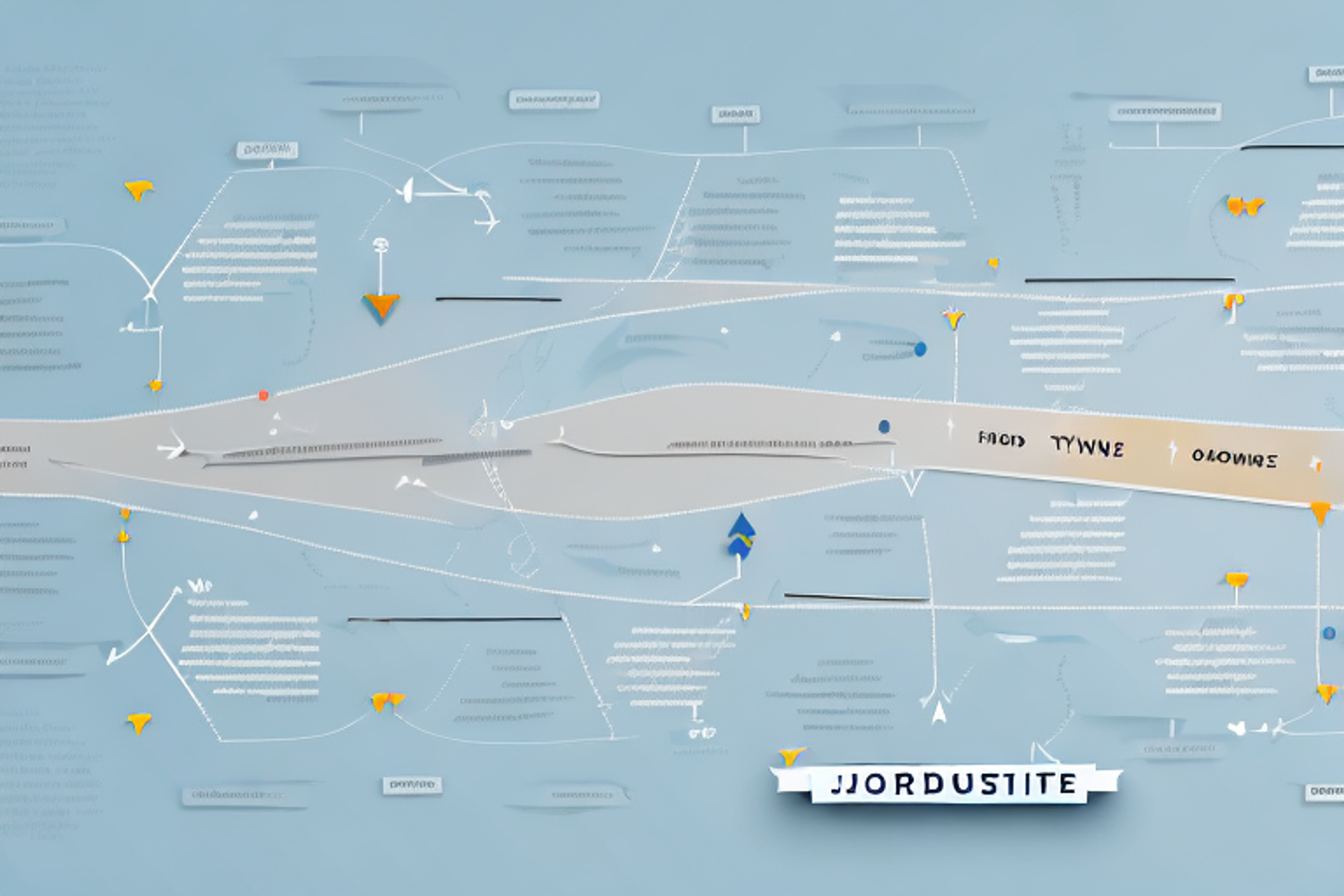Product Strategy Vs. Roadmap: What's the Difference and Why It Matters
Discover the key differences between product strategy and roadmap and why understanding these concepts is crucial for any product manager.
Posted April 10, 2025

Table of Contents
When it comes to developing a successful product, having a clear strategy and roadmap is essential. However, many people use these terms interchangeably, when in reality, they are two distinct concepts that play different roles in the product development process. In this article, we will dive deep into the difference between product strategy and roadmap, their importance, and how to create and implement effective ones for your business.
Understanding the Role of Product Strategy in Business Planning
Product strategy is a high-level plan that defines how a product will achieve its business goals. It outlines the vision, mission, target audience, and value proposition of the product, as well as the overall market and competitive landscape. In essence, it is the guiding principle that defines what the product is, what problems it solves, and how it fits into the broader business strategy and objectives.
Product strategy is critical because it determines the direction of the product development process and sets the tone for all subsequent decisions. A robust product strategy ensures that everyone involved in the product development process is aligned and working towards the same goal. It also enables teams to be more agile and responsive to changes since they have a clear understanding of why the product exists and what it aims to achieve.
Creating an Effective Product Roadmap for Your Business
A product roadmap is a tactical plan that outlines the specific features, functionalities, and milestones that a product team will develop in the near term. It provides a detailed timeline of the product development process, including all the activities and resources required to achieve the goals outlined in the product strategy.
The primary purpose of a product roadmap is to provide clarity and direction for the product team, stakeholders, and users. It helps to facilitate communication, prioritize tasks, and ensure that all parties involved in the product development process are on the same page. Additionally, it provides a clear framework for assessing the progress of the product development process, identifying potential roadblocks, and making any necessary changes to the plan.
The Importance of Defining Your Product Strategy and Roadmap
Both product strategy and roadmap are essential components of a successful product development process. A clear product strategy provides direction and focus, while a well-defined product roadmap ensures that everyone involved in the product development process is working towards a common goal. Together, they help to minimize confusion, prevent miscommunication and ensure that the product team is aligned with the broader business strategy.
How to Align Your Product Strategy and Roadmap with Business Goals
Aligning your product strategy and roadmap with your business goals is essential for ensuring that your product development process is effective and efficient. To achieve this, you need to start by clearly defining your business goals and objectives. Ask yourself, what are the key metrics that you want your product to impact? What problems is your product solving, and how does it align with your business model?
Once you have defined your business goals, you can then use them to inform your product strategy and roadmap. Ensure that your product strategy aligns with your business goals by identifying how your product delivers value to your target audience, how it solves their problems, and how it fits into the broader competitive landscape. Then, use your product strategy to develop a roadmap that outlines the specific features, functionalities, and milestones that your product team will develop to achieve your business goals.
Key Elements of a Successful Product Strategy and Roadmap
There are several key elements that a successful product strategy and roadmap must include. Firstly, your product strategy should outline your product's vision, mission, target audience, value proposition, and how it aligns with your business goals. Secondly, your product roadmap should provide a clear timeline of the specific features, functionalities, and milestones that your product team will develop to achieve your product strategy. It should also include critical performance metrics that will help you measure progress towards your business goals.
Measuring the Success of Your Product Strategy and Roadmap Implementation
Measuring the success of your product strategy and roadmap implementation is critical for ensuring that your product development process is effective and efficient. You can measure success by tracking the key metrics identified in your product roadmap, such as user engagement, conversion rates, and revenue. These metrics will help you identify the impact that your product is having on your target audience and whether it is contributing to achieving your business goals.
Common Pitfalls to Avoid in Developing a Product Strategy and Roadmap
Developing a product strategy and roadmap is not always easy, and many businesses make common mistakes that can hinder their success. One of the most significant pitfalls to avoid is failing to define your business goals clearly. Without clearly defined business goals, your product strategy and roadmap will lack direction and focus, making it challenging to achieve your desired outcomes.
Another common mistake is developing a product strategy and roadmap in isolation without seeking input from stakeholders. To avoid this, ensure that you involve all the relevant stakeholders in the product development process and solicit their feedback and input throughout the process.
How to Communicate Your Product Strategy and Roadmap to Stakeholders
Communicating your product strategy and roadmap to stakeholders is essential for ensuring that everyone involved in the product development process is aligned and working towards a common goal. To communicate effectively, you need to create clear and concise presentations that highlight the critical elements of your product strategy and roadmap.
Ensure that your presentations are tailored to your audience and address their specific concerns and needs. At the same time, be sure to provide context and explain how your product strategy and roadmap align with your broader business strategy and objectives.
The Role of Feedback in Refining Your Product Strategy and Roadmap
Feedback is a critical component of any successful product development process. It enables you to identify potential issues, make necessary changes, and improve your product's overall quality. To get the most out of feedback, you need to be responsive and open to constructive criticism.
Encourage feedback from all stakeholders, including users, customers, and internal teams, and use it to refine and improve your product strategy and roadmap continuously.
Balancing Agility and Planning in Your Product Development Process
Balancing agility and planning is essential for developing a successful product development process. On the one hand, you need to be agile and responsive to changes in the market and user needs, which means being willing to pivot and make necessary changes on the fly.
On the other hand, you also need to have a well-defined product strategy and roadmap that provide direction and focus. By striking the right balance between agility and planning, you can build a product that delivers value to your target audience while remaining responsive to changes in the market and user needs.
Best Practices for Maintaining a Strong Product Strategy and Roadmap Over Time
Maintaining a strong product strategy and roadmap over time requires ongoing effort and attention. To ensure that your product development process remains effective and efficient, you need to regularly review and update your product strategy and roadmap in response to changes in the market and user needs.
Another best practice is to involve all relevant stakeholders in the product development process and maintain regular communication with them to ensure that everyone is aligned and working towards a common goal.
Incorporating Customer Insights into Your Product Strategy and Roadmap
Incorporating customer insights into your product strategy and roadmap is critical for ensuring that your product delivers value to your target audience. To achieve this, you need to regularly conduct user research and gather feedback from your target audience to understand their needs and pain points.
You can then use this information to inform your product strategy and roadmap and ensure that your product is meeting the needs of your target audience.
The Impact of Emerging Technologies on Your Product Strategy and Roadmap.
Emerging technologies are transforming the way we develop and deliver products. As such, it is essential to consider their impact on your product strategy and roadmap.
By staying abreast of emerging technologies, you can identify new opportunities to innovate and provide unique value to your target audience. You can also ensure that your product strategy and roadmap remain relevant and responsive to changes in the market and industry.
Conclusion
Product strategy and roadmap are essential components of the product development process, and they play distinct roles. A well-defined product strategy provides direction and focus, while a detailed product roadmap ensures that everyone involved in the product development process is working towards a common goal.
To create and implement effective product strategy and roadmap, you need to ensure that they align with your broader business goals and objectives and remain responsive to changes in the market and user needs. Additionally, you need to involve all relevant stakeholders in the product development process and incorporate customer insights to ensure that your product is meeting the needs of your target audience.
By following these best practices and avoiding common pitfalls, you can develop a robust product development process that delivers value to your target audience and contributes to achieving your broader business goals.











